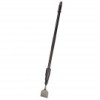Harbor Freight Tools 62687 User Manual - Page 11
Work Piece and Work Area Set Up, General Operating Instructions
 |
View all Harbor Freight Tools 62687 manuals
Add to My Manuals
Save this manual to your list of manuals |
Page 11 highlights
Safety Setup Work Piece and Work Area Set Up 1. Identify the area you intend to scrape. Clear the floor of loose objects. Use care when operating Air Scraper near baseboards. 2. The work area must be well‑lit. The work area must not allow access by children or pets to prevent distraction and injury. 3. Route the air hose along a safe route to reach the work area without creating a tripping hazard or exposing the air hose to possible damage. The air hose must be long enough to reach the work area with enough extra length to allow free movement while working. 4. There must not be hazardous objects (such as utility lines or foreign objects) nearby that will present a hazard while working. General Operating Instructions 1. If an automatic oiler is not used, add a few drops of Pneumatic Tool Oil to airline connection before use. Add a few drops more after each hour of continual use. 2. Hold the Handle (11) and Housing (14). NOTE: If the flooring is made of sectioned tile or linoleum, place the Chisel's edge at the edge of the tile. NOTE: Either side of Chisel tip can do the cutting. 3. Apply forward pressure on the Air Scraper while holding it at approximately 45°- 60° angle. This will help dig into the flooring. See Figure D. Trigger (9) Housing (14) Handle (11) Chisel (26) Figure D Flooring 4. Press the Trigger (9) to begin scraping. Keep pressure on Air Scraper. 5. Push the Air Scraper forward against the material being scraped off. NOTE: Push down on the Scraper's handle. Simply guiding the Scraper will not work. NOTE: When scraping linoleum floors and the flooring comes apart in large sections, stop scraping. Clear and remove debris and use a utility knife (sold separately) to cut and remove the lifted sections together. 6. If the tool requires more force to accomplish the task, verify that the tool receives sufficient, unobstructed airflow (SCFM) and increase the pressure (PSI) output of the regulator up to the maximum air pressure rating of this tool. CAUTION! TO PREVENT TOOL AND ACCESSORY FAILURE, RESULTING IN INJURY: Do not exceed the tool's maximum air pressure rating. If the tool still does not have sufficient force at maximum pressure and sufficient airflow, then a larger tool may be required. 7. When leaving the work area, turn off the air supply valve, disconnect Air Scraper from the air supply, and press the Throttle Lever to discharge any trapped air in the tool and air supply line, then release the Throttle Lever. Lay the tool down on the floor or lean it against a wall corner with the chisel edge resting on the floor. Operation Maintenance Item 62687 For technical questions, please call 1-888-866-5797. Page 11















